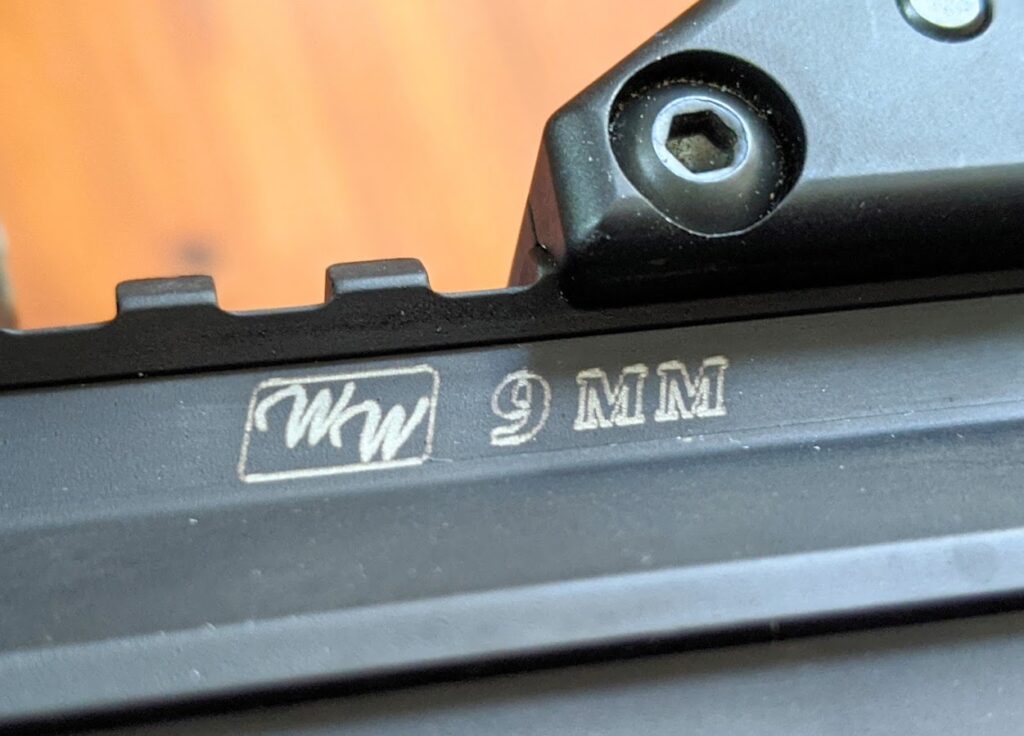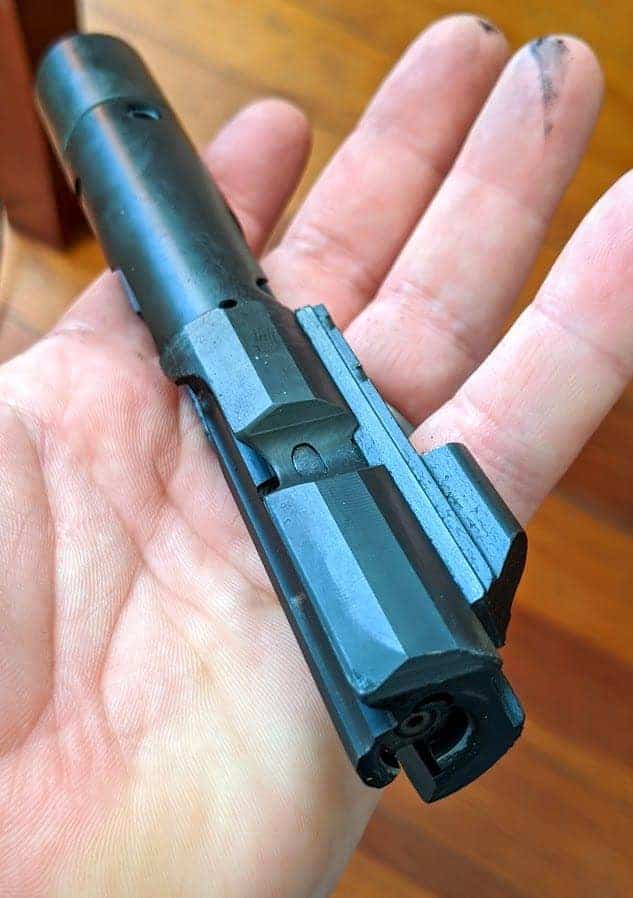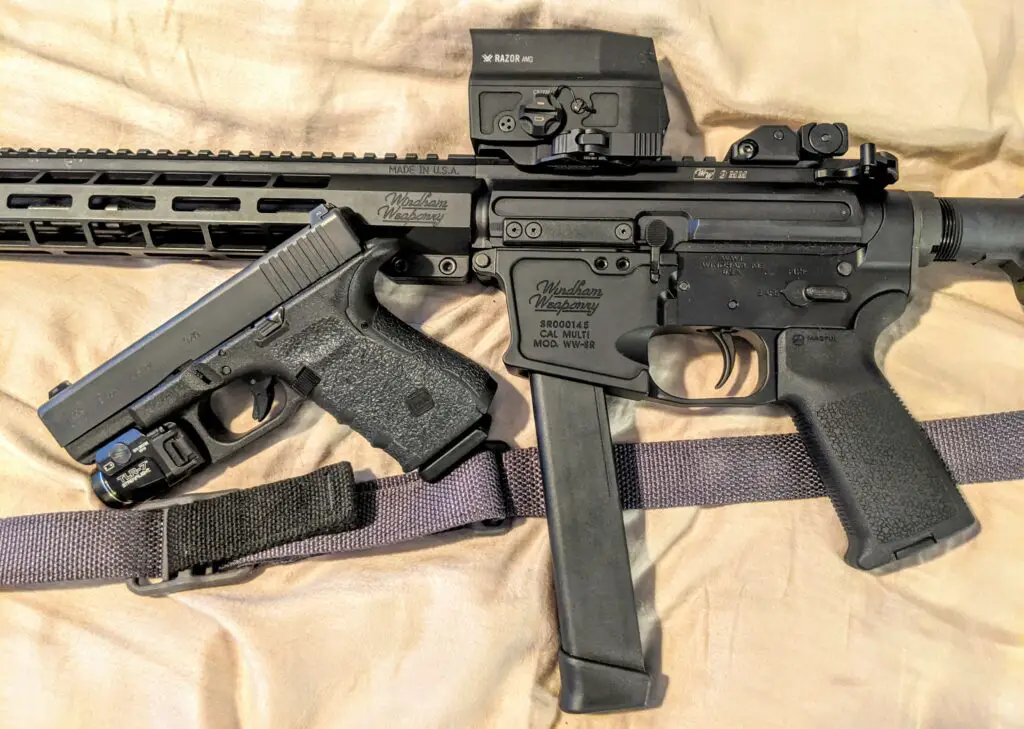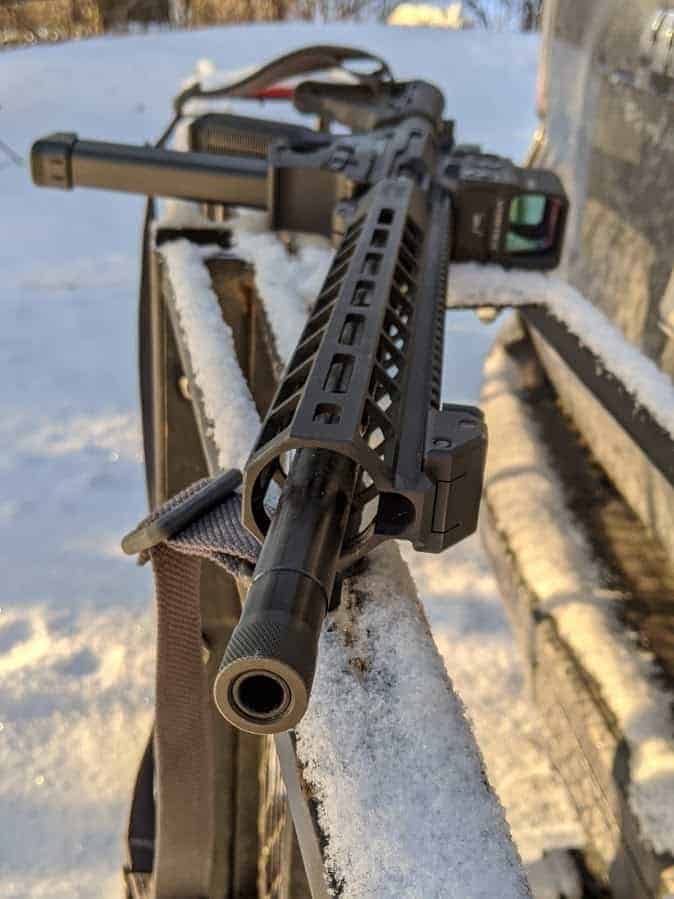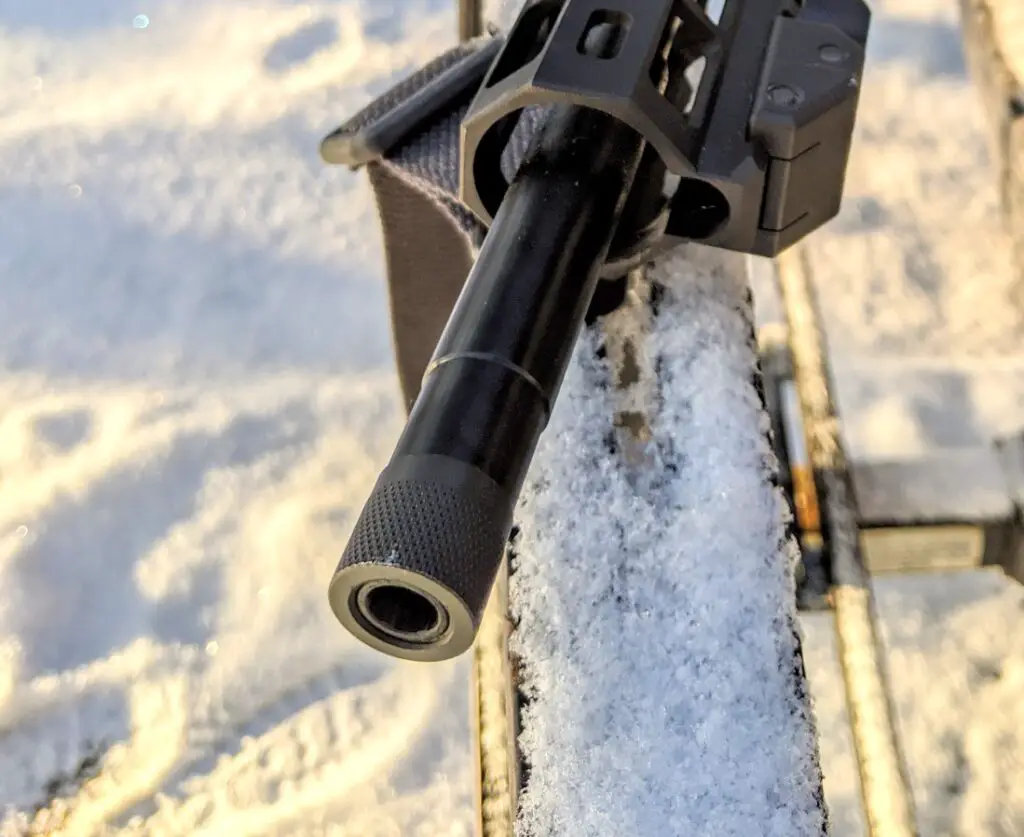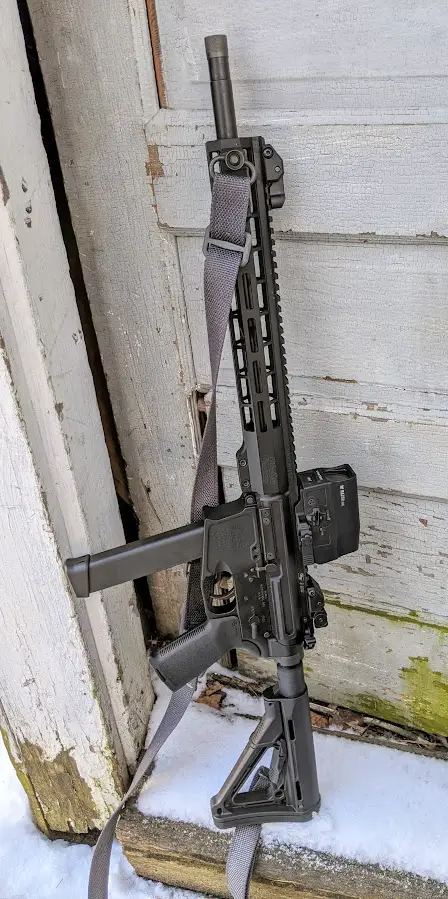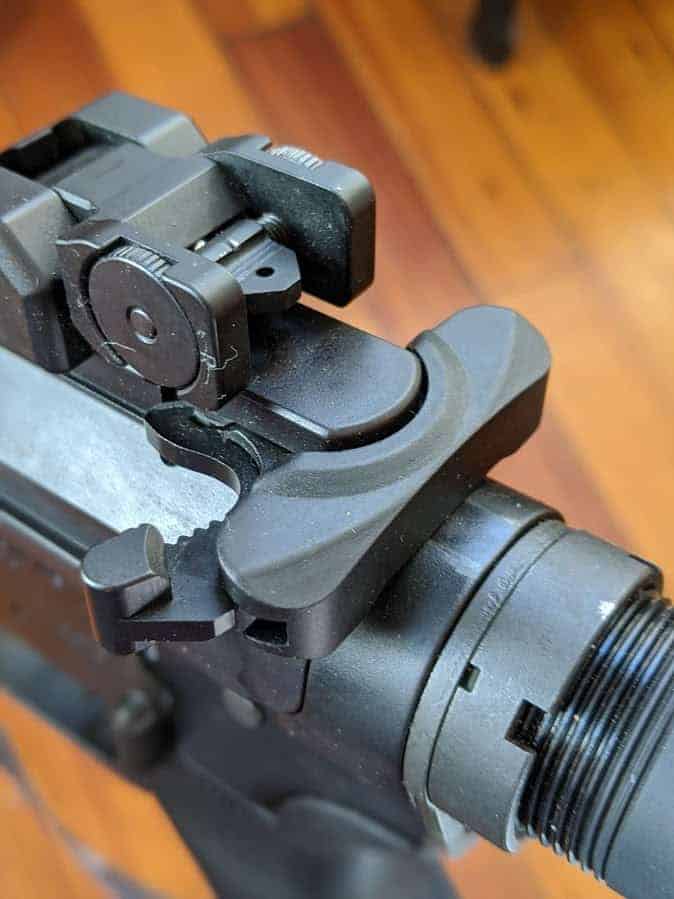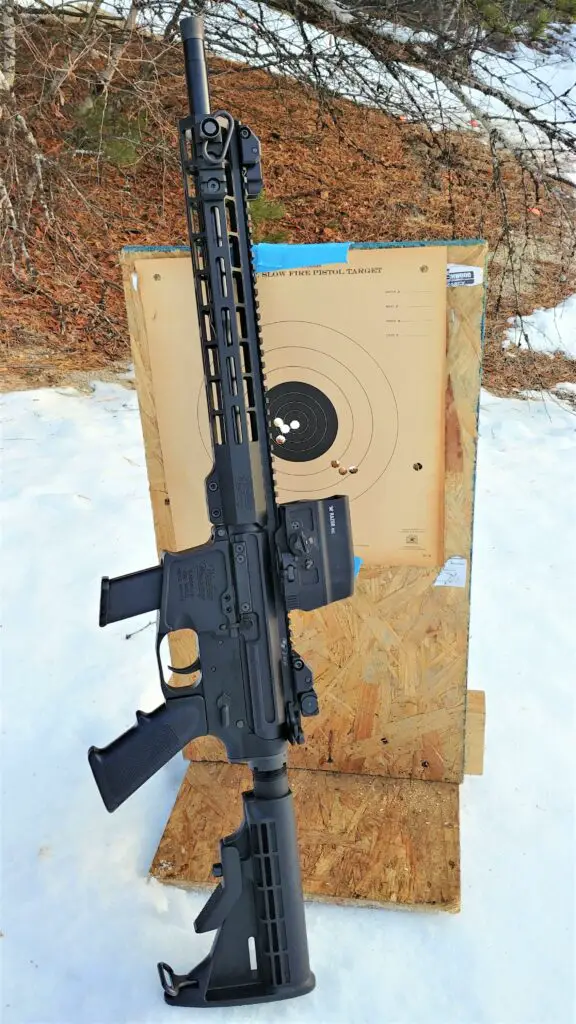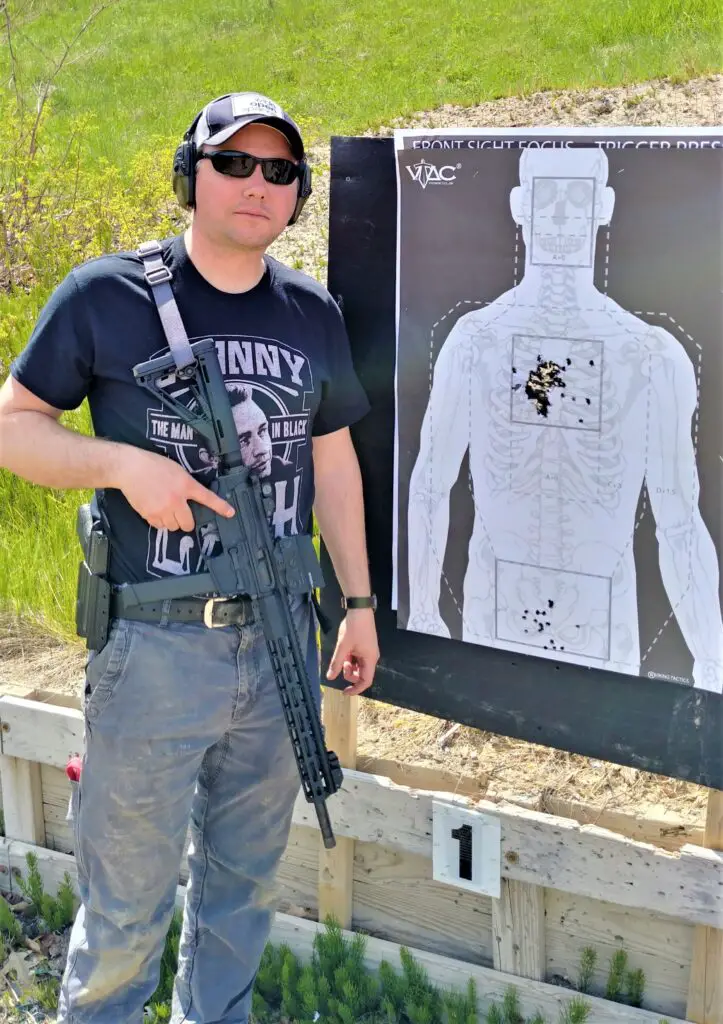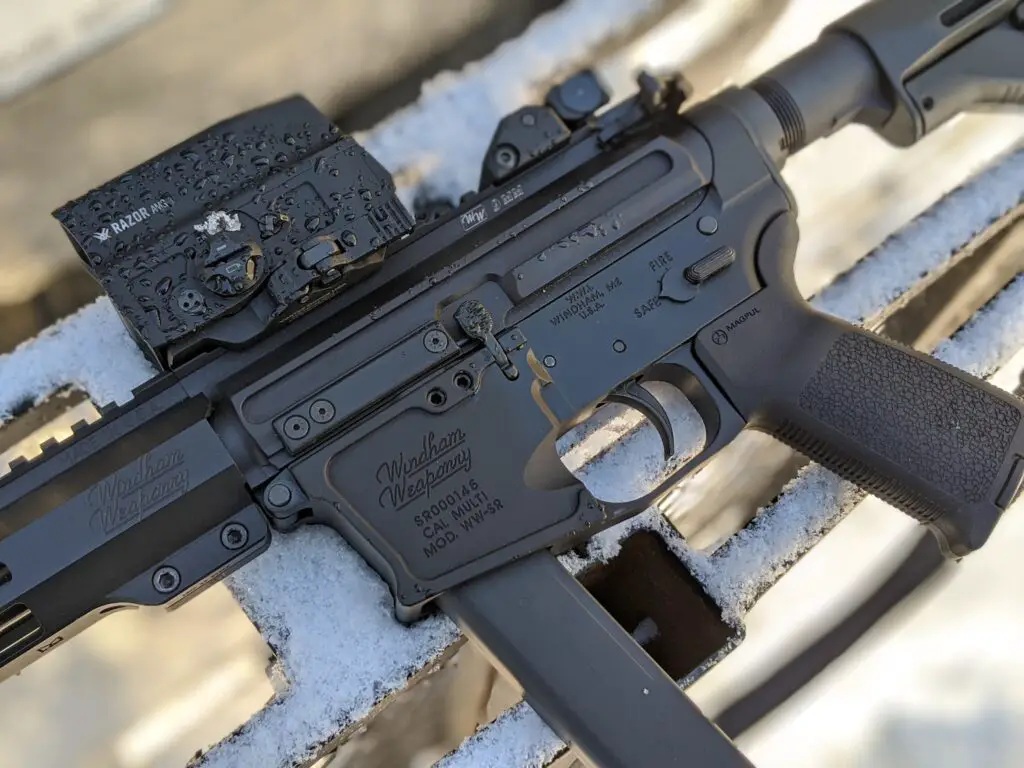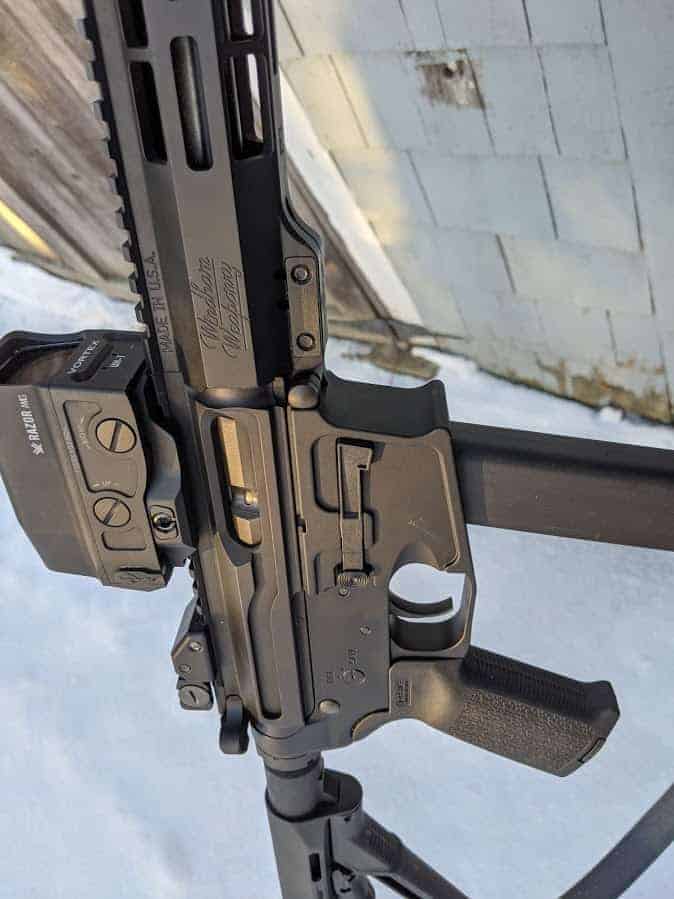I’ll fully admit to initially having been under the influences of a full-blown confirmation bias when I first laid my eyes on the Windham Weaponry R16FTT-9MM carbine. My first impression upon seeing Windham Weaponry’s new carbine was probably similar to how might you feel handling any other Armalite-pattern rifle for the first time: “Yup, it’s another AR.” And that’s what I thought this platform would be; yet another AR. I knew there were some interesting features, but overall, I thought the 9mm carbine would fit into the same manilla envelope that other ARs do, because I had a preconceived notion of what this little black rifle was all about. And I was pleasantly surprised to find that actually running this carbine through its paces steered me away from looking for data to support the conclusion I thought I already knew.
Pistol Caliber Magnificence
And speaking of bolts, popping the R16FTT-9MM’s bolt out of its upper receiver raceway will reveal the big surprise: this gun runs as a straight blowback. That’s right: no gas tubes, no gas ports or blocks, no gas keys to loosen and leak. No separate rotating bolt for a Multi-piece BCG. The gasses from the round going off in the chamber push the bolt backwards and start the process of the carbine’s semi-automatic cycling; the rifle’s springs and physics perform the rest of the work. The straight closed-bolt blowback system has been around for over a century now and is well-developed and dependable – and it’s a great, reliable choice for the operation of this little carbine. Less moving parts than HK’s roller-delayed system, no weird dissimilar metals friction like a Thompson’s Blish Lock. No wildly unpredicatable accuracy from firing from an open bolt. No fuss, all simple, reliable goodness. It should even work well as a suppressed rig, too; no worrying if your gas port is correctly sized or properly gassed.
Glock Perfection in an AR package
Also read: Magpul PMAG27 Glock Magazine
Making magazine acquisition even easier is the fact that Magpul now offers high-quality, inexpensive 9mm Glock magazines; as a matter of fact, our subject carbine shipped with a Magpul 17-round magazine straight from Windham Weaponry.
The 9mm Glock magazine compatibility is a Godsend to those wanting to design a single-caliber centerfire pistol/carbine plan; instead of trying to source the clunky Colt stick mags, SIG Sauer’s proprietary $60-each MPX magazines, or even pricier HK MP5 magazines, you can walk into any Cabela’s or reasonably well-stocked gun store and find rugged, proven magazines on the rack for dirt money; my last purchase was a Magpul 17-round magazine for $15.99 at Cabelas. I even found used Magpul 15-round mags at a local gun shop for $10 each. Though I don’t know why someone would discard anything that has “Magpul” moulded into it, I snatched them up with glee and they function with aplomb. I bought the 33-round Glock-made mags for $25 each on sale from Brownell’s.
Icing on the polymer cake: while there are several manufacturers who make 9mm AR lowers – a few of whom manufacture with Glock magazine capability – whittling down this category further is the need for a 9mm AR lower that runs on Glock mags, AND ALSO locks the bolt back when the mag runs dry. The Windham Weaponry 9mm carbine checks all the above boxes with a flawless bolt hold-open feature. A rifle that’s theoretically designed for battle or competition (or maybe really intense hunting?) should absolutely lock the bolt back when the mag runs dry. Major kudos to Windham Weaponry for making sure the rifle operates as we expect an AR-platform rifle should.
Suppressor Ready
I visited my buddy with the SIG Sauer MPX-C that I reviewed a couple years ago so I could do a 9mm carbine comparison and take advantage of the SilencerCo Octane 9HD that he obtained for the SIG. However, the muzzle thread pitches are entirely different between the two guns, so I sadly wasn’t able to play with the Windham Weaponry 9mm suppressed. And with the thread adapter for an Octane 9 being about $90, I’ll have to save the suppressed report (pun intended) for a later date. But the ability is there, so a tax form is in my future, I predict. I mean, it only makes sense, right? Right.
Not Bad Out Of the Box, But…
Some may argue that these designs are perfectly adequate and functional, and they are absolutely right. However, after having my cheek pinched in some buttstock-receiver extension junctions a couple times, and wrestling with trying to retrofit a proper two-point sling on the buttstock, I just bit the bullet and purchased a black Magpul CTR buttstock and MOE pistol grip. These two simple additions added a touch of storage and a healthy serving of increased utility with the ability to properly mount a Blue Force Gear Vickers two-point sling on QD mounts fore and aft. This setup proved its worth on a carbine course and during numerous drills at the sandpit. Don’t get me wrong: Windham Weaponry provides a serviceable setup out of the box – and props to them for providing a complete package – but for a few extra bucks (MOE Grip – $20, CTR Stock – $60, Blue Force Gear Sling $55) you get a pistol-caliber wonder carbine that wants for nothing in the ergonomics and utility department.
The only other change I made was to swap out the stock style charging handle for a BCM Gunfighter Mod 4 piece with a left-side extension. More on the important “why?” of that modification here in a second – and it ain’t just for increased handle leverage.
You’ll also need to source sights and/or an optic to run this carbine properly. I had some kicking around, thankfully – but a set of decent BUIS will be probably around $60-70 to start – and optics can range from Wal-Mart $39 cheapies to red dots and ACOGs that will make you take an unsteady knee when you pull out the wallet. The Windham Weaponry 9mm AR carbine’s picatinny rail will gladly give any of them a solid home.
Yeah, But How Does It Shoot?
Related: Survival Gear Review: SIG Sauer MPX-C
A few steps back to 50 yards confirmed that I was still on paper, and an adjustment to bring the bullet impact about an inch high at 50 yards worked well. A five-shot group from the kneeling position at 50 yards measured about 1 ½” or so. I then stood, and proceeded to handily perforate a 1-liter soda bottle shot for shot at the 100-yard marker. The gun was a shooter for sure – better than I expected.
When I was testing handloads and some other factory ammunition through the Windham Weaponry 9mm carbine, I found that resulting group size varied wildly by bullet type and weight, but all of the loads produced usable accuracy – especially when you consider that a stubby 9mm bullet ain’t exactly a ballistic wonder. I settled on a handload that played nice in the W-W carbine and my Glock 19; the load pushed a 124-grain Hornady FMJ bullet at about 1,250 fps – and grouped in the 4” range at 100 yards. I think the carbine could have done a bit better with a proper magnified optic, but the Vortex’s holographic reticle was incredibly fast and positive to work with – and 100-yard 4” groups from a 9mm carbine was A-OK with me. High-end defensive ammo did shoot markedly better, with Remington Golden Saber 124-grain +P loads in particular providing excellent accuracy.
The R16FTT-9MM proved to be boringly reliable. It gobbled up every nasty lead bulleted handload I made, every hollow point defense load I offered it, and every steel-cased crap Wolf load I dropped the hammer on. To this day, with probably close to 3,000 rounds through the rifle, I have yet to experience a malfunction with the gun – though I make sure to clean and lube the rifle often due to the blowback action’s rapid carbon buildup.
Running the 9mm Carbine in the Real World
I recently took a carbine course through SRT Concepts here in Maine (outstanding company for training, check them out if you’re in the New England Area). I checked with Peter Joyce, the instructor, ahead of time, and asked if I could run two guns at the course so I could compare a pistol caliber carbine against my normal 5.56mm AR. He liked the idea and welcomed me to run both rifles, as long as I was fully communicative with the instructors about swapping guns and following enhanced safety procedures while walking to and from the firing line with different rifles.
The carbine course was stellar, and a real eye-opener with the function, performance, and perception differences between the two calibers. On the base level, the two guns were approximately the same – my 5.56 AR even has a Windham Weaponry heavy barrel! – with collapsible Magpul stocks, 16” barrels, and identical sling setups. Optics were different, as my 5.56 rifle sports a Leupold Mk AR 1.5x-4 on a Burris PEPR mount, while I elected to run the 9mm carbine with the non-magnified Vortex AMG UH-1 holographic sight in keeping with the close-in philosophy the pistol-caliber platform promotes.
Related: Survival Gear Review: Windham Weaponry R18FSFSM-308
The guys on the line either side of me appreciated the 9mm carbine greatly. My 5.56 AR wears a Seekins Precision muzzle brake that is hugely effective at taming muzzle rise, but blasts concussively every time the rifle goes off. (I was told by my instructor that the muzzle blast was flapping my neighbor’s shirt around!) The 9mm carbine was launching 124-grain bullets at about 1,250 feet per second, making the rifle seem almost suppressed in comparison!. Reportedly the 9mm AR was much more comfortable to stand near while I was shooting. Even with no muzzle device, there were no issues with muzzle rise or blast. This is a major consideration for anyone possibly running this gun indoors – whether it be a warrant-serving police officer, or a homeowner defending his family.
The 9mm carbine’s quick handling characteristics were a joy on the range, and the safety was positive and crisp – a welcome characteristic indeed, especially when working near other shooters with plenty of distraction. Knowing through haptic feedback – a nice positive “click” – that the safety was fully engaged or fully disengaged when I operated it was a Godsend.
(Very Minor) Trouble in Paradise
Issues? Yeah, a couple – but these were not really the gun’s fault, just struggles that manifested themselves via the differences in magazine design. You see, due to the feeding angle of Glock magazines imparted by Gaston Glock’s grip design, the Windham Weaponry’s magazines rake backwards slightly in the magazine well and require a different insertion angle when reloading from the shoulder. Where a standard 5.56mm magazine inserts straight up into the magazine well, the 9mm magazines require you to cant your wrist forward and slant the top of the magazine slightly forward when inserting. I also had a bit of luck inserting a magazine sort of like an AK, with the top of the magazine facing my head and then rocking it upwards and into the magwell. However, this technique didn’t work as well with tactical reloads when you had to juggle two magazines with one hand.
The other issue I found was that though magazines generally dropped free when the release was pushed, the smaller, lighter 17 and 15 round pistol mags very occasionally had enough polymer-to-aluminum friction to hang up and require a yank or a shake while performing a reload from the shoulder. Not the end of the world, but another step to work through when you need the gun topped off in a hurry. I did find that this hang-up phenomenon occurred mostly when the rifle had been in a position where the magazine had some lateral pressure on it, usually from leaning against a barricade or cover.
Training and repetition will help you through both of these issues decisively, but I found that swapping back and forth between the 9mm and 5.56 platforms had me confused when it came time for fast reloads. Keep that in mind if you like having lots of different rifles.
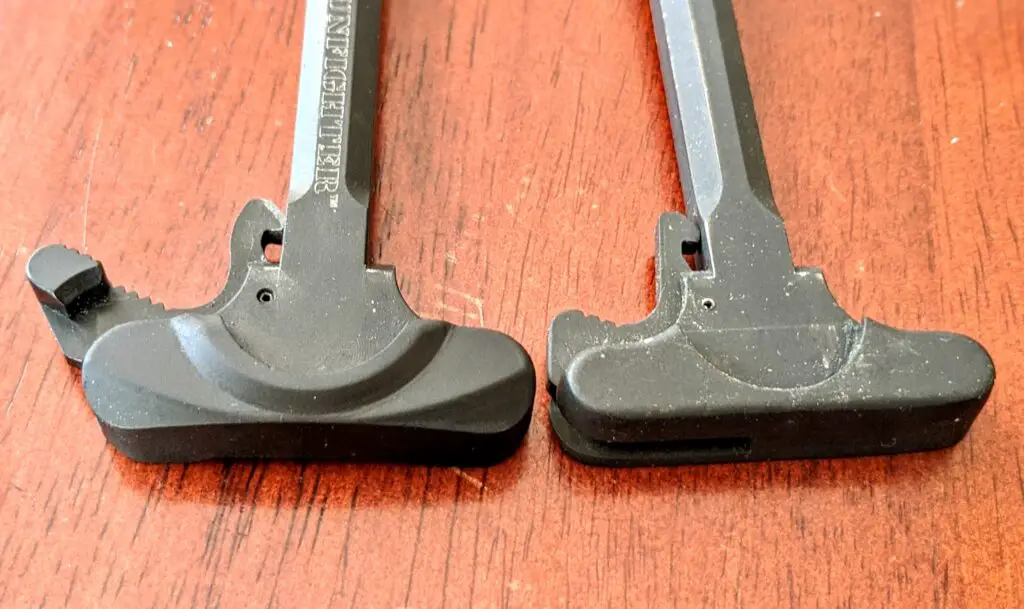
BCM charging handle (left) vs. stock. Note the built-up half-circle area on the BCM.
The other problem I’d found (actually before I took the course) centered around the 9mm carbine’s blowback operating system. Every time the rifle went off, the gun cycled and hot gasses from the expended cartridge made their way back through the charging handle keyway, and blew directly on my eyes. I never noticed the problem while wearing eye protection, like I do 99.9% of the time – but the one time I didn’t use eye pro, the hot gasses expelling backwards rushed into my eyes like a rowdy heat gun directed on my face. It was uncomfortable to say the least – and while dry eyes aren’t fun, unburnt powder, case debris, or other carbon residue could travel with the gasses – possibly disabling your eye. Lesson one: always use eye protection. Lesson two: ditch the stock charging handle and source a replacement unit that has a built-up “wall” of material on the top of the part – this mitigates the gasses nicely. The BCM charging handle I dropped in the carbine (standard AR charging handles work just fine!) enhanced the gun’s manual of arms with increased leverage for operating the bolt from the shoulder, and it deflected hot gasses nicely.
Of all the swapped parts I changed out on the Windham Weaponry 9mm carbine, I would consider the charging handle swap the most important – a huge safety upgrade for your face and peepers. When the SHTF or that home invader kicks the door open at 2am, think you’ll be wearing safety glasses? Even odds that you won’t be. Keep that in mind.
Brass Tacks
If you think this 9mm carbine is “Just another AR”, get past your own confirmation bias and try one out. You’ll realize for yourself that an AR in 9mm is an absolute platform enhancement when combined with a sidearm that uses the same feeding system. Pistol caliber carbines paired with a compatible pistol are hot right now – shooters and preppers are recognizing the versatility, effectiveness, and minimalist leanings of the concept. And there’s no better combo (in my humble opinion) than a Glock 19 and a Windham Weaponry R16FTT-9MM carbine. Grab one of each (or more, that’s cool too), stock up on cheap, reliable magazines and some cases of ammo, and proudly possess the best pairing of shooting tools on the market – they’re ready when you are, no matter what hits the fan.



